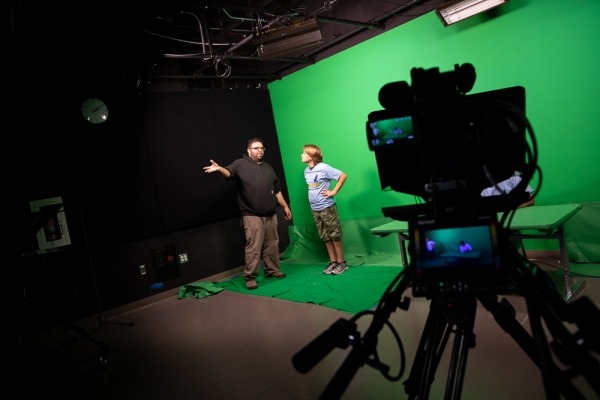It’s a scenario played out in broadcast studios in countless cities every day: Anchors stand in front of cameras, reading from a teleprompter in a room separated by glass from program directors, who yell “cut!” when it’s time for a reshoot.
But this isn’t a metropolitan news studio, or even that of a small community-based operation like the nearby Midpeninsula Community Media Center. Instead, it’s the scene that regularly unfolds in the Hillview Middle School video broadcast studio, home to a 23-student advanced video broadcast class offered to seventh- and eighth-graders at the Menlo Park school. Students, some of whom have now gained national recognition for their work, tell stories on their daily morning announcement show, “HawkTalk,” and produce a biweekly news entertainment broadcast, “HVTV.”
Advanced broadcast students go live every Monday for “HawkTalk,” but prerecorded content is played as a part of the morning announcements on other days.
“It’s opened me up to this whole world,” said eighth-grader Mercedes, who is on the team of students directing the shows. “There’s something about creating things for school and seeing your work shown for the school.”
Mercedes has learned to edit videos and has gained leadership skills, she said. Students like Mercedes put these film skills to use for school plays.
Broadcast students film the plays and learn about multicamera shoots that patch to the studio for a live edit, said Hillview student activities director and broadcast teacher Brian Darmanin. Students capture the performances using a variety of wide, medium, and close up shots, he said.
The advanced broadcast class is the brainchild of Darmanin, who also teaches the school’s beginners broadcast class.
Previously involved with CNN’s political debate show, “Crossfire,” Darmanin became Hillview’s broadcast director in 2011. It took years and thousands of dollars in technology equipment — a teleprompter, new video cameras and tripods, a TriCaster (a multi-camera production system), among other items — to make it a successful program, he said.
The new broadcast studio opened in 2012 as part of the Hillview campus renovation funded by Measure U, a $91.1 million bond measure that passed in 2006. Materials for the broadcast studio, two music classrooms, the Performing Arts Center, and integration of a public address (PA) and video system to support drama events cost the district about $400,000, according to Ahmad
Sheikholeslami, Menlo Park City School District’s chief business and operations officer.
Before the campus renovation, the old broadcast studio was “very bare bones,” and was basically a converted utility closet with jury-rigged equipment, said Hillview Principal Willy Haug, who joined the school staff more than 20 years ago as a teacher.
“What’s really changed (about the broadcast program) is the creative capability — due to the technology and Brian’s expertise,” said Haug. “Those creative touches make it more professional and compelling.”
Run by the students
The students produce everything that’s aired on “HVTV” and “HawkTalk” exclusively, Darmanin said.
“It’s a true program — they (the students) do it on their own,” he said. “There’s not an adult saying: ‘do this or do that.’”
It’s also more than just morning announcements students produce, edit and film. Students do feature stories on topics touching on school life and the Menlo Park community. They produce segments on topics such as the newest bakery on Santa Cruz Avenue, computer screen addiction, and Hillview teacher profiles.
The daily broadcast also helps foster a powerful and positive culture at a big school — the middle school serves grades 6 through 8 and has 975 students, said Principal Haug. It’s important to have a regular opportunity to communicate information and various reminders to students, he noted.
“Students are much more engaged and tuned into what’s going on (with the video announcements),” he said.
Jackson, an eighth-grader and Hillview’s student body president, joined the class this school year. “HawkTalk” is about turning morning announcements into “something that’s not boring,” he said.
Awards
Students began submitting their work for awards under Darmanin’s guidance. Some of the students gained national recognition for their videos. In early December, Hillview students took home an honorable mention from Student Television Network (STN) Challenge competition for a 48-second public service announcement about plastic pollution. Two students came up with the idea to use the Bay Area’s proximity to water and incorporate plastic pollution as a coastal cleanup reminder of what plastic use does to the environment.
For the competition, teachers can’t help students. Competition organizers give students a topic on a set date with six days to film, edit and submit their video by a deadline. This pressure empowers students to use the skills they learn in class, Darmanin said.
In 2016, students obtained press credentials to film at Super Bowl City in San Francisco. Three Hillview students won an honorable mention — in the middle school news or feature story category — at the 2016 STN Nationals for their video on the NFL Experience at the free-to-the-public fan village.
Media skills: From storytelling to iMovie
At the beginning of the school year — in August and September — Darmanin trains video production students in various production and post-production skills. These skills include: shot composition/framing, A-Roll/B-Roll capture, narration/script writing and other storytelling elements such as shot types, he said.
In post-production, students start with the video-editing program iMovie, since 99 percent of news features use basic “cuts” and iMovie is approachable, but powerful, Darmanin explained.
Throughout the school year, students are quizzed on these skills.
“It’s not: ‘how they get there (to learn the skill),’” he said. “It’s: ‘Did they learn the skill or not?’ It’s just like learning to play an instrument. They shouldn’t be punished for struggling.”
Jack, an eighth-grader who is also on the team of students directing the shows, said running the program is a special experience.
“You do things you wouldn’t do in other classes,” he said.
Darmanin is “hands off” for the most part, Jack said, allowing students to take on leadership roles. Jack said he’s found that some other teachers will talk over students or dump a lot of information on students at once, but Darmanin lets students run the class.
“We all get a taste of leadership being in this class,” Jack said. “Mr. Darmanin is the guy who has the expertise to step in and will empower you.”
Students also learn how to be good storytellers, Darmanin said. He tells students to look for heart and angle when choosing stories.
Heart comes from having a central character to follow in a story, he said. He also advises them to break from the norm or expected angle to make audiences think. When there’s heart and angle, you’ve produced something magical, he said.
“If you can tell a story and have the tech competencies, you have a career,” he said. “These kids tell such amazing stories — look what a 13-year-old can do. This (producing broadcast programs) is really tough to do.”
Darmanin holds a post-mortem with students weekly to critique the segments. This can be difficult, especially for middle schoolers who are at a sensitive age, but students get used to the post-mortems when it’s constructive feedback, he said.
“They (the students) are open to fair criticism and can laugh at themselves,” he said.
Lasting effects
The program has stuck with alumni who continue to use skills they learned in Hillview’s broadcast program, far past middle school graduation day.
Maya Khodabakchian, a Menlo-Atherton High School sophomore, participated in Hillview’s broadcast program as a seventh-grader and credits it with teaching her “the skill of being able to tell stories via video.”
“The end product is always so much fun — when people learn (from your video), that’s the most rewarding part,” said Maya, 15, who added that the class influenced her love of making videos.
She is using her skills to make science-related instructional videos.In September, Maya was a Breakthrough Junior Challenge semifinalist for her video explaining brain neuroplasticity.
She’s currently researching Elon Musk’s neuroscience company Neurolink and wants to make a short video explaining the company’s goals.
Although Maya says she is unlikely to pursue a career in film or video journalism, she believes videos are the future of conveying information.
“Videos are taking over, for better or for worse,” she said.
Future of the program
Darmanin notes that the broadcast program is made up of a “special group of students who push themselves” and give up other electives to take part in it.
He said that it’s his dream that Hillview broadcast students will compete in national contests annually. He also would like to connect the broadcast program to Menlo-Atherton High, where most of his students move on to. Third on his list? Initiating a film festival run by Peninsula middle schools.
To watch more Hillview broadcast student videos, go to HillviewTV.com
-







Comments